Optimal Scheduling of Integrated Community Energy Systems Based on Twin Data Considering Equipment Efficiency Correction Models
Abstract
1. Introduction
- (1)
- The built visual model, based on Cloudpss, combines a large amount of historical data and mathematical models and forms a digital twin that can simulate the optimal output of the units under different working conditions of the physical system. The twin data are fed back to the physical equipment in real time to adjust the output of each physical equipment. Second, the LSTM prediction model that is based on the digital twin can achieve the ultra-short-term accurate prediction of the output and load of the new energy units based on real-time data and historical data;
- (2)
- The twin data are processed using polynomial regression and back propagation neural networks to extract the characteristics of the equipment conversion efficiency in relation to the load factor and environmental factors and, finally, correct the equipment conversion rate to minimise the dispatching cost. The twin-based efficiency correction is more reflective of the actual operating conditions of ICESs than using historical equipment data to correct efficiency, and avoids the waste of electricity, heat, and hydrogen.
2. Digital-Twin Technology
Digital-Twin Technology Framework
- (1)
- The physical entity module mainly contains components such as the installed capacity of the integrated energy system devices, energy-coupling devices, energy storage devices, and load types, which is the information source for the simulated operation of the digital twin, provides real-time data for the digital twin, and can receive feedback information from the digital twin and the service modules [22];
- (2)
- The digital twin module is a real-time mapping of the physical entities and consists of a combination of a visualisation model and a dynamic twin model that constantly iterates on itself to correct the twin parameters based on real-time data from the physical entities. As a result, it more accurately reproduces the operation of the physical equipment in a real environment and provides a better scheduling solution for the energy system;
- (3)
- The digital twin database module is the key driver of the twin. A part of the data is generated by the virtual simulation, reflecting the simulation results; another part of the data is obtained from the service module for service invocation and execution; and the rest of the data are provided by experts in the field with professional standard data from the twin;
- (4)
- The data connection module is the data transmission layer, which uses switches and an ethernet as the core to build a wireless-network transmission system to realise the efficient transmission of meteorological data, equipment operation data, etc. A combination of distributed local storage and centralised cloud storage is used to store data comprehensively, which can realise the dynamic response and mutual call of data according to the system’s requirements. Through the IoT perception and the ubiquitous network, new elements, trends, and problems in the physical world are dynamically tracked by the virtual power grid, and the virtual-power-grid revision model keeps time and space consistent [23];
- (5)
- The service module includes the application services considering the load-side demand response and power system monitoring, transmission-line diagnosis, forecasting, and health management to ensure the safe operation of the integrated energy system.
3. Equipment Efficiency Correction Modelling
3.1. DEH Efficiency Correction Model Based on Twin Data
- 1.
- Cogeneration equipment twin
- 2.
- Gas boiler twin
- 3.
- Electrolysis tank twin
- 4.
- Steam methane reforming twins
- 5.
- Energy storage device twin
- 6.
- Energy storage device twins are used in order to compensate for the intermittence and fluctuation of renewable energy units such as photovoltaic generation and wind turbines and to bring their advantage into play. Energy storage devices are devices in the system that undertake the task of peaking (storing energy when energy prices and loads are low and releasing energy when they are conversely high), relieving the pressure on the equipment supply and achieving operational flexibility of the system. In this paper, a generic model of energy storage was used to model the energy storage twin, as follows:where are the energy storage state of the ith energy storage twin at moments t and t−1, respectively; is the charging and discharging efficiency; and are the charging and discharging power of the ith twin at moment t, respectively; is the rated capacity of the energy storage twin; is the actual charging and discharging power of the twin after the loss of the charging and discharging efficiency at moment t; Δt is the scheduling time difference, with a step of 1 h; and cn is the type of energy storage equipment.
3.2. Energy Conversion Rate Correction Strategy Based on Twin Data
4. ICES Day-Ahead Scheduling Model
4.1. Binding Conditions
4.2. DT-LSTM-Based Ultra-Short-Term Prediction Model
5. Results
5.1. Parameter Setting
5.2. Optimal Analysis of Day-Ahead Scheduling with a Modified Model of Equipment Efficiency Considering Twin Data
6. Discussion
7. Conclusions
Author Contributions
Funding
Institutional Review Board Statement
Informed Consent Statement
Data Availability Statement
Conflicts of Interest
References
- Hou, H.; Liu, P.; Xiao, Z.; Deng, X.; Huang, L.; Zhang, R.; Xie, C. Capacity configuration optimization of standalone multi-energy hub considering electricity, heat and hydrogen uncertainty. Energy Convers. Econ. 2021, 2, 122–132. [Google Scholar] [CrossRef]
- Lin, W.; Jin, H.; Jia, H.; Mu, Y.; Xu, T.; Xu, X.; Yu, X. Decentralized optimal scheduling for integrated community energy system via consensus-based alternating direction method of multipliers. Appl. Energy. 2021, 302, 117448. [Google Scholar] [CrossRef]
- Liu, X.; Xie, S.; Geng, C.; Yin, J.; Xiao, G.; Cao, H. Optimal evolutionary dispatch for integrated community energy systems considering uncertainties of renewable energy sources and internal loads. Energies 2021, 14, 3644. [Google Scholar] [CrossRef]
- Xu, Y.; Mu, Y.; Cao, Y.; Jia, H.; Wu, G.; Wang, X. Deep neural network-based low-carbon economic dispatch of integrated energy systems under variable operating conditions. High Volt. Technol. 2022, 48, 11. [Google Scholar] [CrossRef]
- Liu, F.; Mo, Q.; Yang, Y.; Li, P.; Wang, S.; Xu, Y. A nonlinear model-based dynamic optimal scheduling of a grid-connected integrated energy system. Energy 2022, 243, 123115. [Google Scholar] [CrossRef]
- Saletti, C.; Morini, M.; Gambarotta, A. Smart management of integrated energy systems through co-optimization with long and short horizons. Energy 2022, 250, 123748. [Google Scholar] [CrossRef]
- Lv, C.; Yu, H.; Li, P.; Wang, C.; Xu, X.; Li, S.; Wu, J. Model predictive control based robust scheduling of community integrated energy system with operational flexibility. Appl. Energy 2019, 243, 250–265. [Google Scholar] [CrossRef]
- Zhang, G.; Ge, Y.; Ye, Z.; Al-Bahrani, M. Multi-objective planning of energy hub on economic aspects and resources with heat and power sources, energizable, electric vehicle and hydrogen storage system due to uncertainties and demand response. J. Energy Storage 2023, 57, 106160. [Google Scholar] [CrossRef]
- Ji, Y.; Wang, J.; Xu, J.; Li, D. Data-driven online energy scheduling of a microgrid based on deep reinforcement learning. Energies 2021, 14, 2120. [Google Scholar] [CrossRef]
- Liu, Y.; Zhang, N.; Kang, C. A review on data-driven analysis and optimization of power grid. Autom. Electr. Power Syst. 2018, 42, 157–167. [Google Scholar]
- Fan, S.; Li, L.; Wang, S.; Liu, X.; Yu, Y.; Hao, B. Application analysis and exploration of artificial intelligence technology in power grid dispatch and control. Power Syst. Technol. 2020, 44, 401–411. (In Chinese) [Google Scholar]
- Yang, H.; Jin, Z.; Wang, J.; Zhao, Y.; Wang, H.; Xiao, W. Data-driven stochastic scheduling for energy integrated systems. Energies 2019, 12, 2317. [Google Scholar] [CrossRef]
- Mu, Y.; Xu, Y.; Cao, Y.; Chen, W.; Yu, X.; Jin, X. A two-stage scheduling method for integrated community energy system based on a hybrid mechanism and data-driven model. Appl. Energy 2022, 323, 119683. [Google Scholar] [CrossRef]
- Huang, W.; Zhang, N.; Wang, Y.; Capuder, T.; Kuzle, I.; Kang, C. Matrix modeling of energy hub with variable energy efficiencies. Int. J. Electr. Power Energy Syst. 2019, 119, 105876. [Google Scholar] [CrossRef]
- Mu, Y.; Chen, W.; Yu, X.; Jia, H.; Hou, K.; Wang, C.; Meng, X. A double-layer planning method for integrated community energy systems with varying energy conversion efficiencies. Appl. Energy 2020, 279, 115700. [Google Scholar] [CrossRef]
- Park, H.; Byeon, G.; Son, W.; Jo, H.; Kim, J.; Kim, S. Digital twin for operation of microgrid: Optimal scheduling in virtual space of digital twin. Energies 2020, 13, 5504. [Google Scholar] [CrossRef]
- Wang, L.; Hou, C.; Ye, N.; Wang, H.; Yin, C.; Cong, H. Optimal operation analysis of integrated community energy system considering the uncertainty of demand response. IEEE Trans. Power Syst. 2021, 36, 3681–3691. [Google Scholar] [CrossRef]
- de Costa, R.L.C. Convolutional-LSTM networks and generalization in forecasting of household photovoltaic generation. Eng. Appl. Artif. Intell. 2022, 116, 105458. [Google Scholar] [CrossRef]
- You, M.; Wang, Q.; Sun, H.; Castro, I.; Jiang, J. Digital twins based day-ahead integrated energy system scheduling under load and renewable energy uncertainties. Appl. Energy 2022, 305, 117899. [Google Scholar] [CrossRef]
- Lu, J.; Yan, L.; La, Z.; Liu, X.; Ren, H. Real-time optimal dispatching strategy for integrated energy systems based on digital twin and dynamic energy efficiency model. Power Grid Technol. 2022, 2033-2437, 1–17. [Google Scholar] [CrossRef]
- Qi, Q.; Tao, F.; Hu, T.; Anwer, N.; Liu, A.; Wei, Y.; Wang, L.; Nee, A. Enabling technologies and tools for digital twin. J. Manuf. Syst. 2021, 58, 3–21. [Google Scholar] [CrossRef]
- Zhu, Q.; Huang, S.; Wang, G.; Moghaddam, S.K.; Lu, Y.; Yan, Y. Dynamic reconfiguration optimization of intelligent manufacturing system with human-robot collaboration based on digital twin. J. Manuf. Syst. 2022, 65, 330–338. [Google Scholar] [CrossRef]
- Bai, H.; Wang, Y. Digital power grid based on digital twin: Definition, structure and key technologies. Energy Rep. 2022, 8 (Suppl. 16), 390–397. [Google Scholar] [CrossRef]
- Li, C.; Yang, Y.; Wang, Z.; Wang, N.; Wang, L.; Yang, Z. Energy hub-based optimal planning for integrated energy systems considering part-load characteristics and synergistic effect of equipment. Glob. Energy Interconnect. 2021, 4, 169–183. [Google Scholar] [CrossRef]
- Wang, Y.; Hou, K.; Jia, H.; Mu, Y.; Zhu, L.; Li, H.; Rao, Q. Decoupled optimization of integrated energy system considering CHP plant based on energy hub model. Energy Procedia 2017, 142, 2683–2688. [Google Scholar] [CrossRef]
- Deng, S.; Wu, Q.; Jing, Z.; Wu, L.; Wei, F.; Zhou, X. Optimal capacity configuration for energy hubs considering part-load characteristics of generation units. Energies 2017, 10, 1966. [Google Scholar] [CrossRef]
- Yuan, Z.; Jing, Z.; Hu, R.; Wu, Q. Operation optimization of CCHP-type microgrid considering units’ part-load characteristics. In Proceedings of the 2015 IEEE Innovative Smart Grid Technologies—Asia (ISGT ASIA), Bangkok, Thailand, 3–6 November 2015. [Google Scholar] [CrossRef]
- Meybodi, M.; Behnia, M. A study on the optimum arrangement of prime movers in small scale microturbine-based CHP systems. Appl. Therm. Eng. 2012, 48, 122–135. [Google Scholar] [CrossRef]
- Kenna, E.; Bannister, P. Simple, fully featured boiler loop modelling. In Proceedings of the Eleventh International IBPSA Conference, Glasgow, Scotland, 27–30 July 2009. [Google Scholar]
- Song, H.; Liu, Y.; Bian, H.; Shen, M.; Lin, X. Energy, environment, and economic analyses on a novel hydrogen production method by electrified steam methane reforming with renewable energy accommodation. Energy Convers. Manag. 2022, 258, 115513. [Google Scholar] [CrossRef]

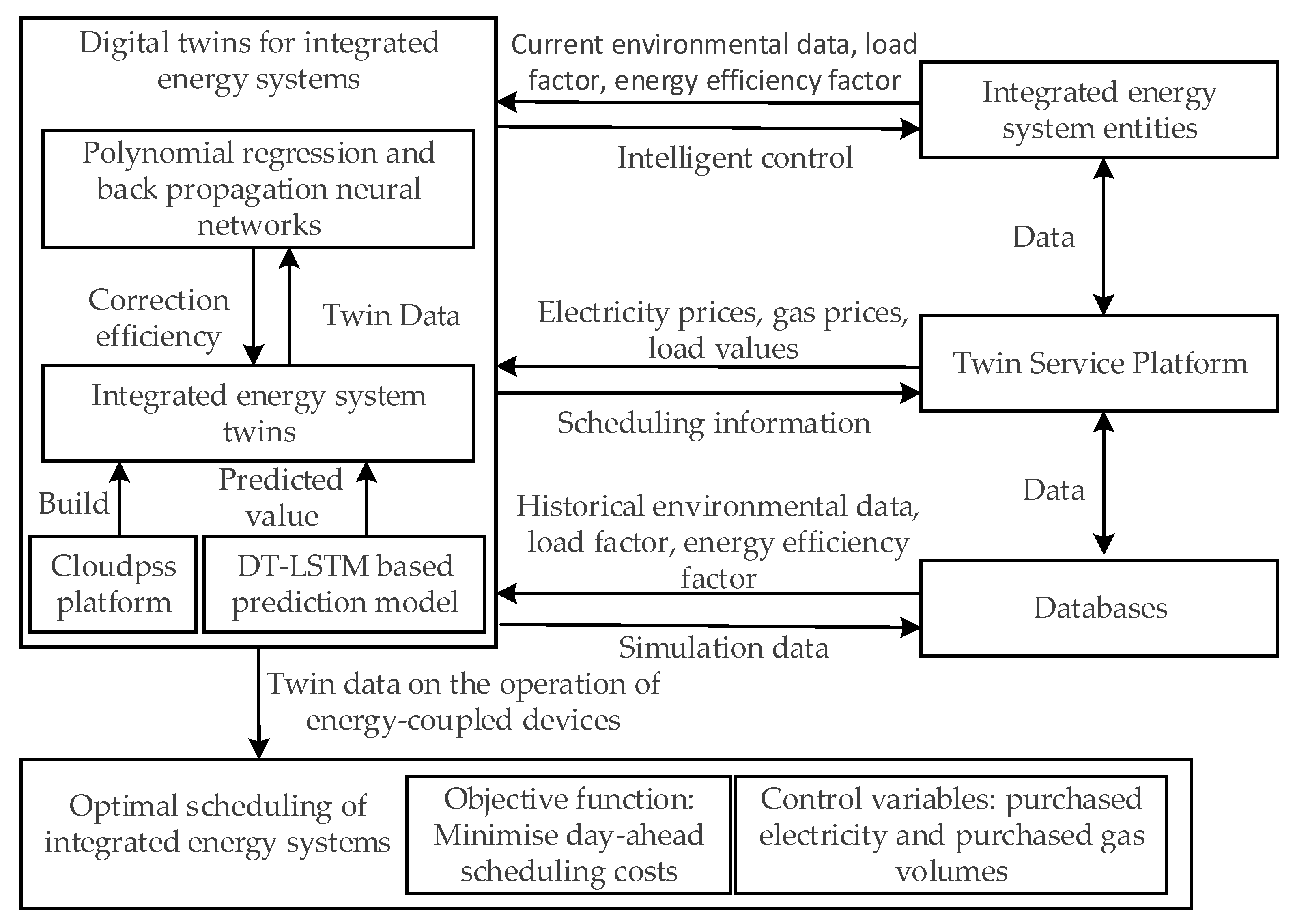



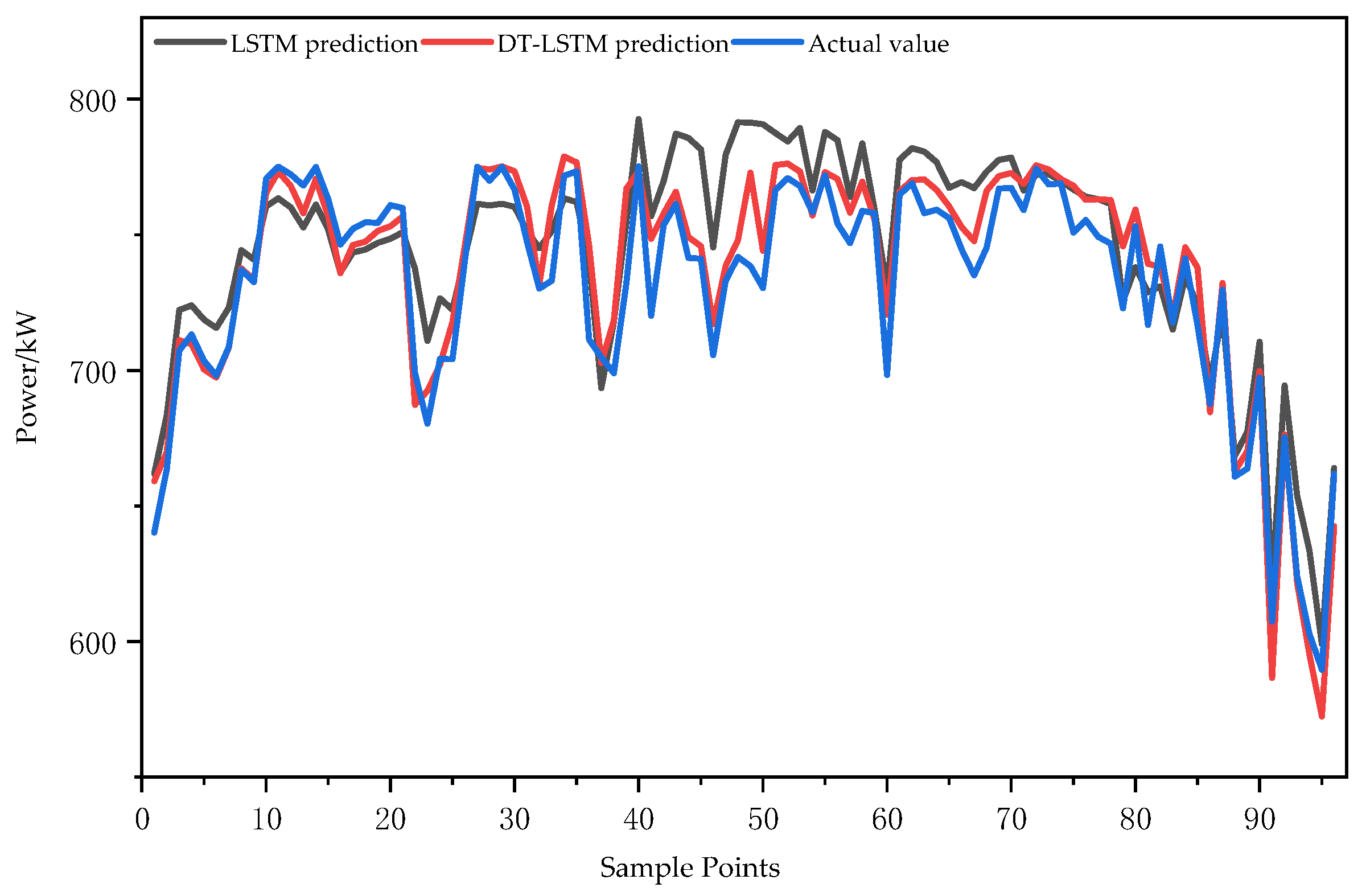
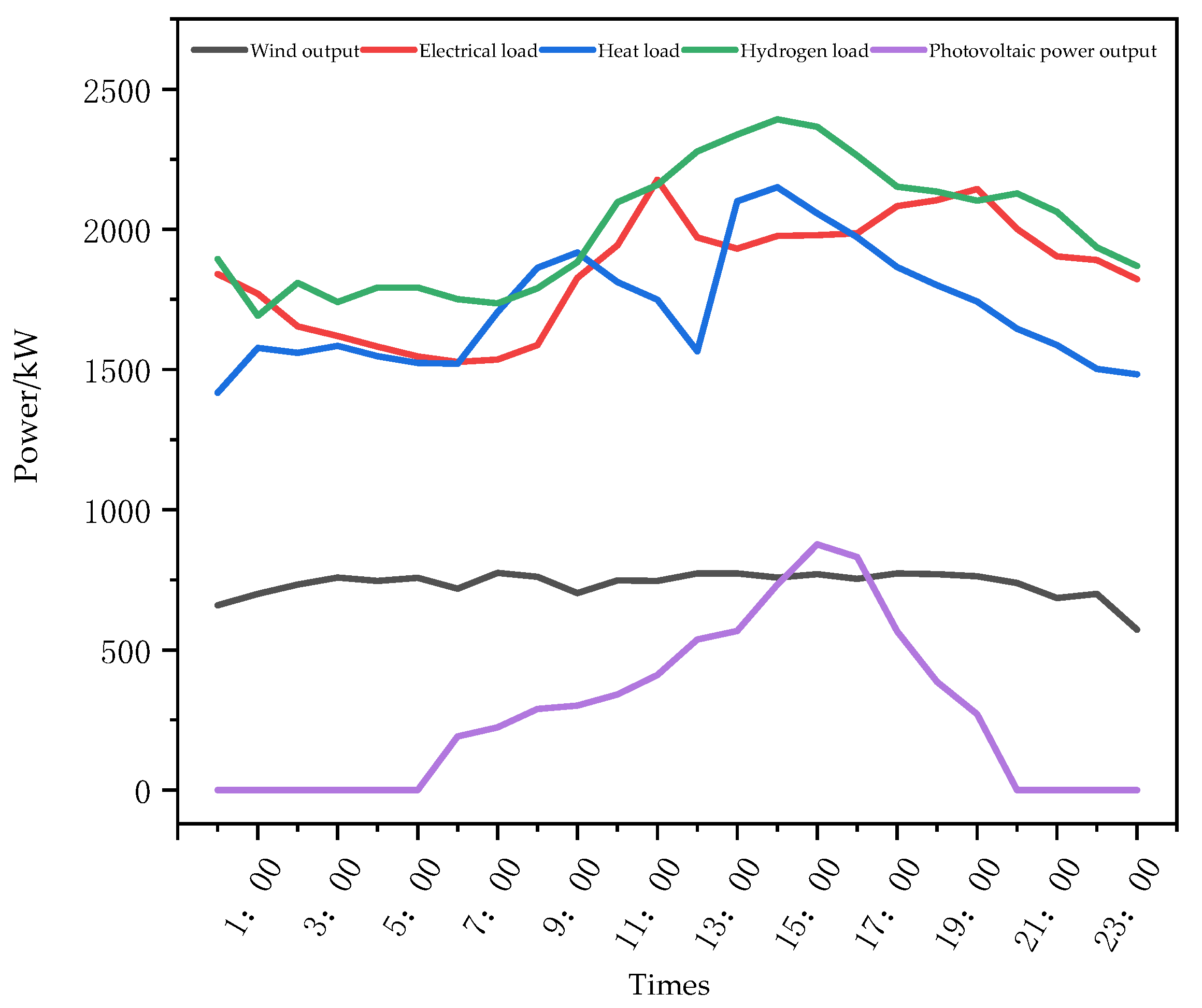
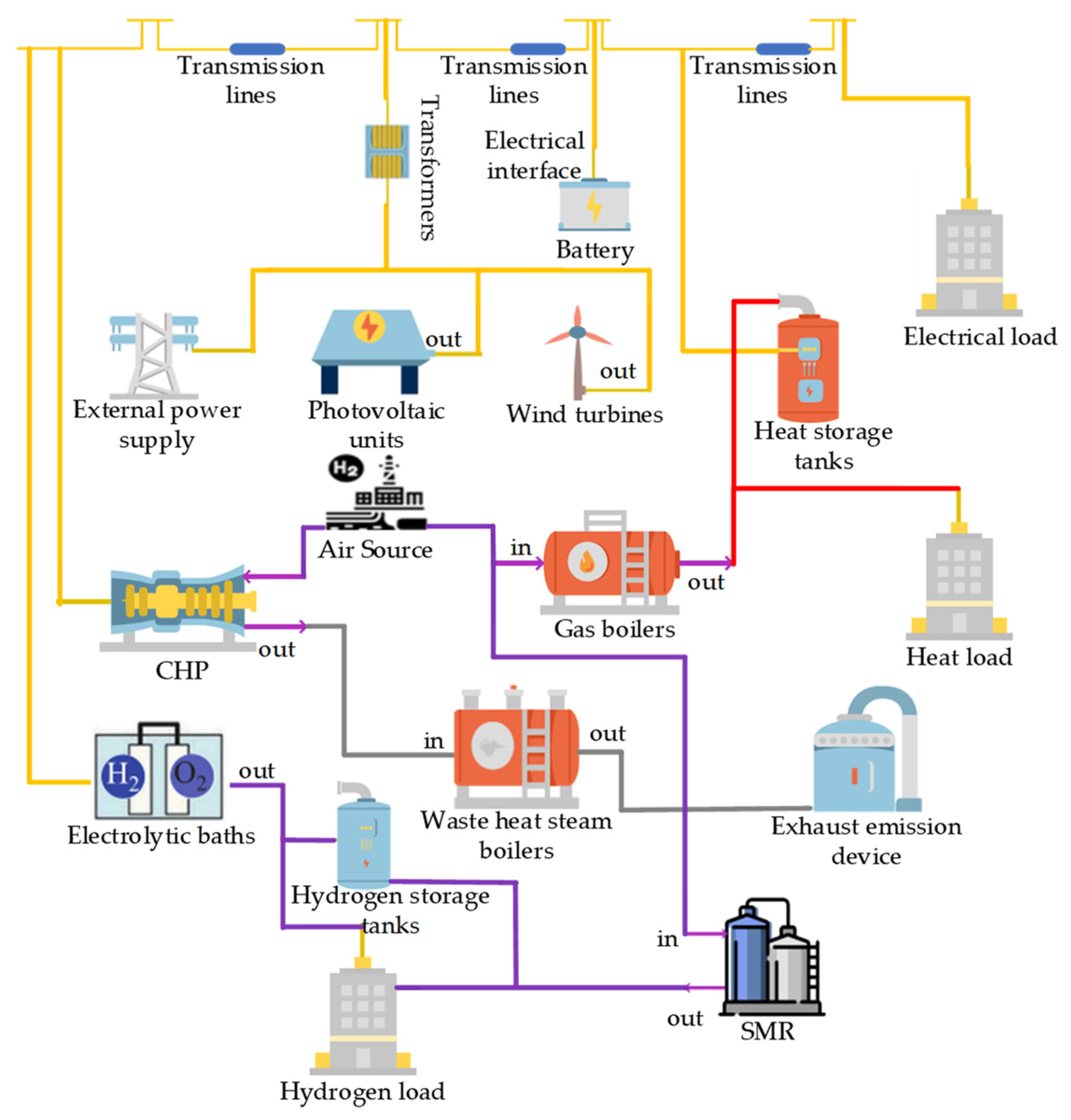


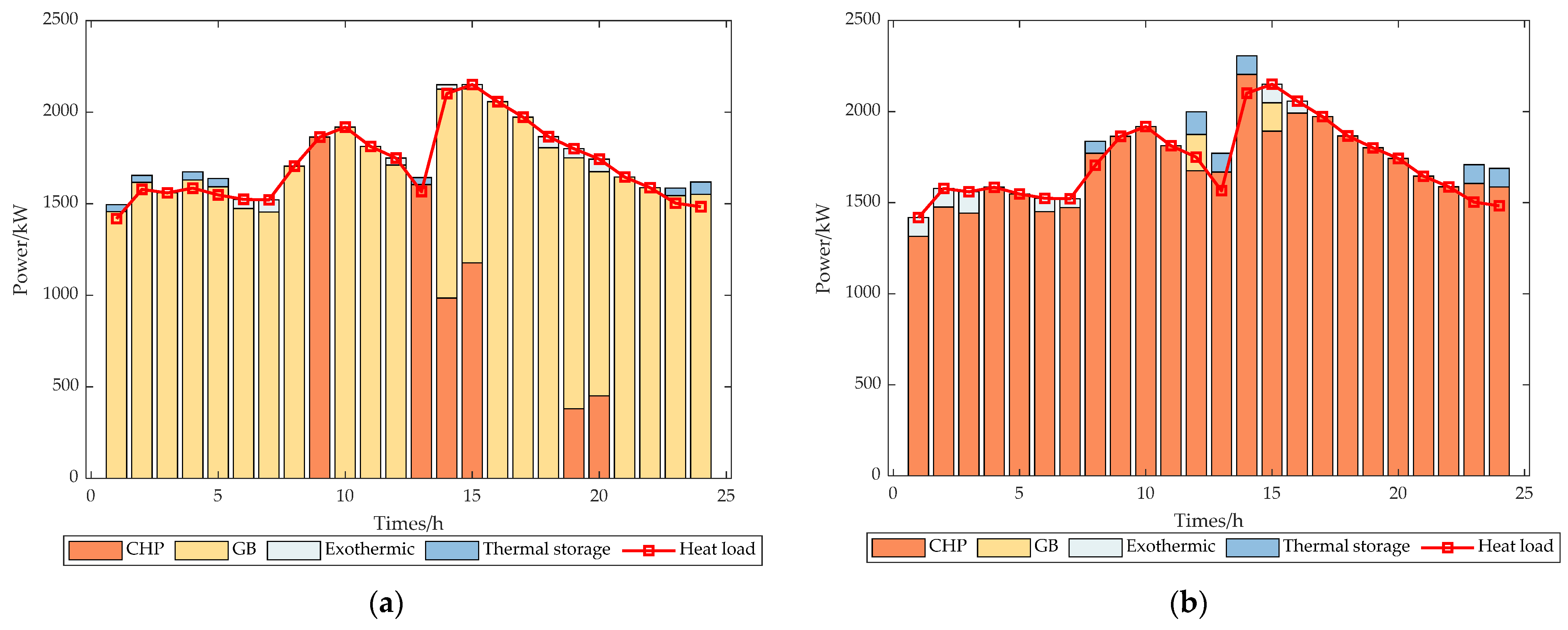
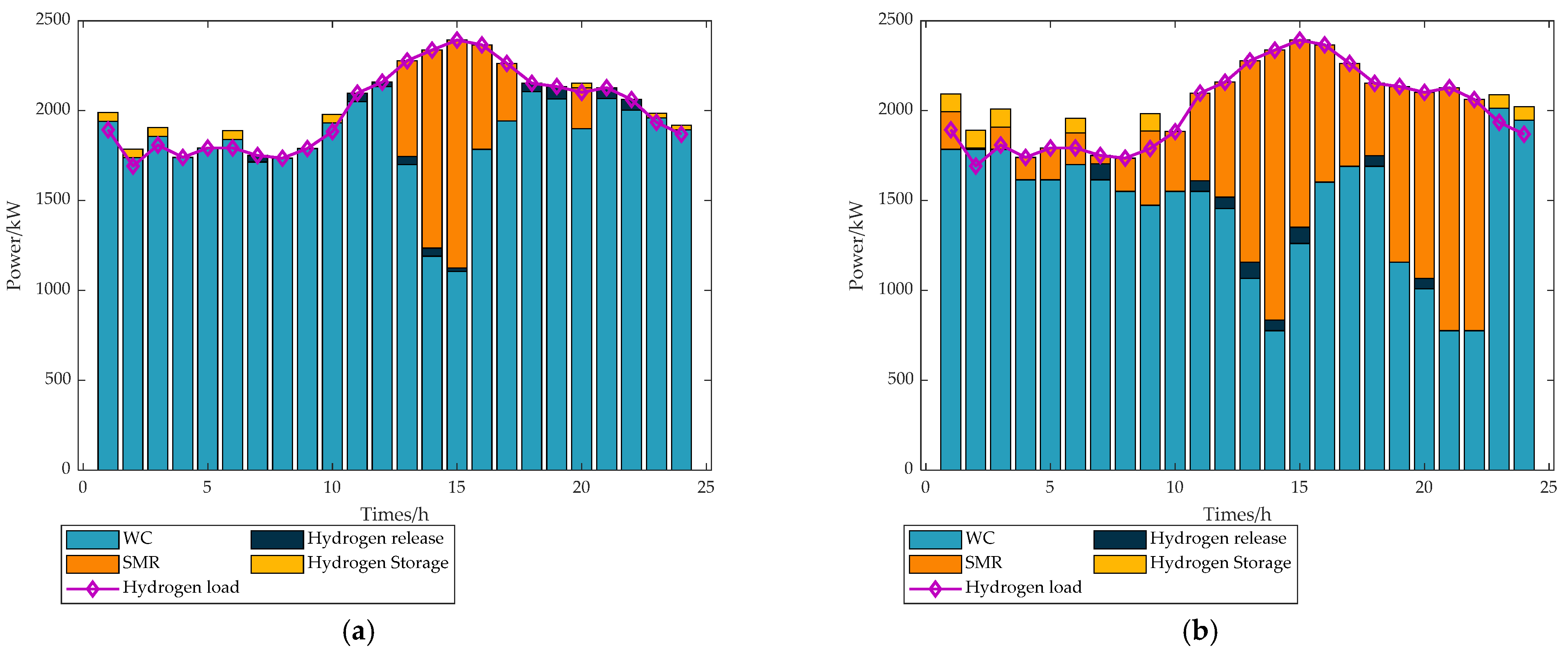
| Energy-Coupling Equipment | Type of Parameter | Numerical Value |
|---|---|---|
| CHP | Rated capacity/kW | 220 |
| Rated gas-to-electricity efficiency | 0.47 | |
| Electrical heat ratio | 1.94 | |
| CHP twin fitting factor | 0.76 | |
| Gas boilers | Rated capacity/kW | 220 |
| Rated gas-to-heat efficiency | 0.93 | |
| Gas boiler twin fit coefficients | 0.86 | |
| Electrolysis tank | Rated capacity/kW | 170 |
| Rated electric-to-hydrogen efficiency | 0.75 | |
| Electrolyser twin fitting factor | 0.68 | |
| SMR | Rated capacity/kW | 200 |
| Rated gas-to-hydrogen efficiency | 0.46 | |
| SMR twin fitting factor | 0.56 | |
| Battery | Rated capacity/kW·h | 300 |
| Maximum charging/discharging power/kW | 90 | |
| Charging/discharging efficiency | 0.85 | |
| Heat storage tanks | Rated capacity/kW·h | 300 |
| Maximum charging/discharging power/kW | 15 | |
| Charge/discharge thermal efficiency | 0.9 | |
| Hydrogen storage tanks | Rated capacity/kW·h | 200 |
| Maximum hydrogen charging/discharging power/kW | 60 | |
| Hydrogen charging/discharging efficiency | 0.8 |
| Parameter | Time | Price |
|---|---|---|
| 0:00–23:00 | 3.12 USD/m3 | |
| 0:00–7:00 | USD 0.42 | |
| 8:00–9:00, 14:00–16:00, 21:00–22:00 | USD 0.63 | |
| 10:00–13:00, 17:00–20:00 | USD 0.76 |
| Case | Mean Absolute Error | Average Relative Error |
|---|---|---|
| 1 | 7.1567 | 2.07% |
| 2 | 2.4861 | 0.89% |
| Scene | Cost of Electricity Purchase/USD | Gas Purchase Cost/USD | Total Cost/USD |
|---|---|---|---|
| Scene 1 | 11,076.6 | 9793.63 | 20,870.23 |
| Scene 2 | 7775.8 | 10,622 | 18,397.8 |
| Scene 3 | 10,722.74 | 10,997.68 | 21,720.42 |
Disclaimer/Publisher’s Note: The statements, opinions and data contained in all publications are solely those of the individual author(s) and contributor(s) and not of MDPI and/or the editor(s). MDPI and/or the editor(s) disclaim responsibility for any injury to people or property resulting from any ideas, methods, instructions or products referred to in the content. |
© 2023 by the authors. Licensee MDPI, Basel, Switzerland. This article is an open access article distributed under the terms and conditions of the Creative Commons Attribution (CC BY) license (https://creativecommons.org/licenses/by/4.0/).
Share and Cite
Ye, Z.; Huang, W.; Huang, J.; He, J.; Li, C.; Feng, Y. Optimal Scheduling of Integrated Community Energy Systems Based on Twin Data Considering Equipment Efficiency Correction Models. Energies 2023, 16, 1360. https://doi.org/10.3390/en16031360
Ye Z, Huang W, Huang J, He J, Li C, Feng Y. Optimal Scheduling of Integrated Community Energy Systems Based on Twin Data Considering Equipment Efficiency Correction Models. Energies. 2023; 16(3):1360. https://doi.org/10.3390/en16031360
Chicago/Turabian StyleYe, Zeli, Wentao Huang, Jinfeng Huang, Jun He, Chengxi Li, and Yan Feng. 2023. "Optimal Scheduling of Integrated Community Energy Systems Based on Twin Data Considering Equipment Efficiency Correction Models" Energies 16, no. 3: 1360. https://doi.org/10.3390/en16031360
APA StyleYe, Z., Huang, W., Huang, J., He, J., Li, C., & Feng, Y. (2023). Optimal Scheduling of Integrated Community Energy Systems Based on Twin Data Considering Equipment Efficiency Correction Models. Energies, 16(3), 1360. https://doi.org/10.3390/en16031360






